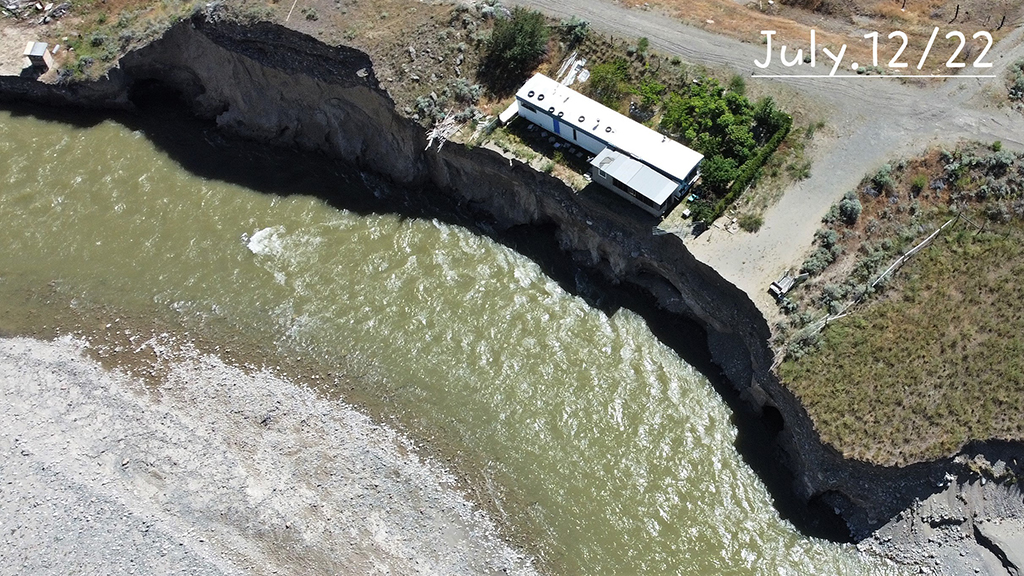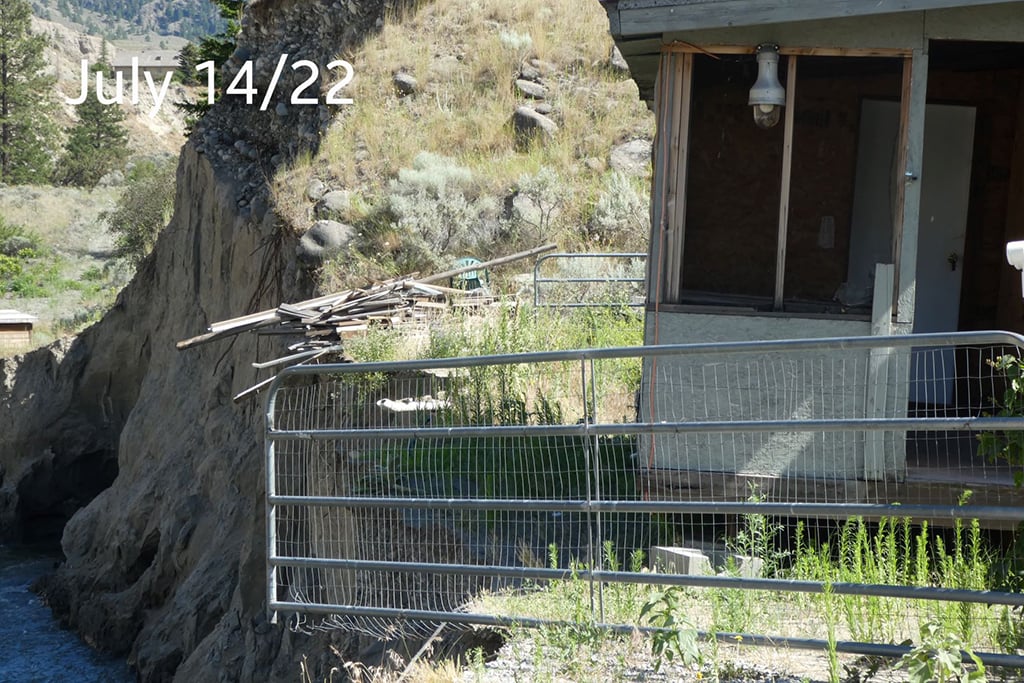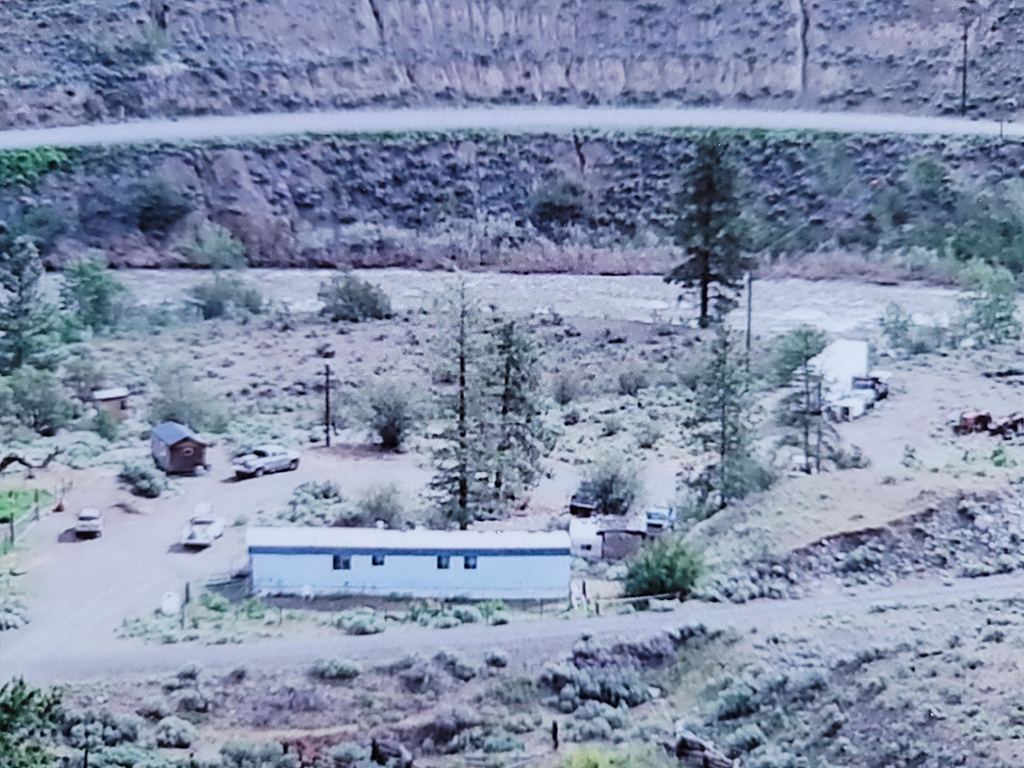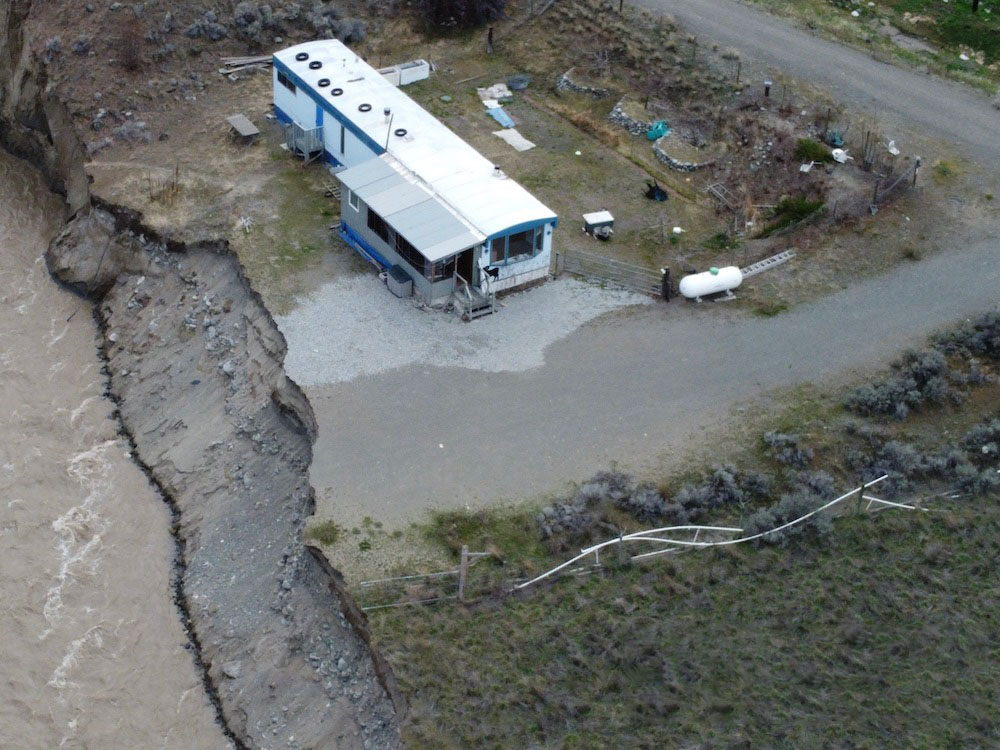A house sitting on the edge of the Nicola River in the Interior is at risk of being swept away after extreme weather eroded the land that used to exist between the house and the water.
In May, the Ministry of Environment and Climate Change Strategy pulled the home back from the eroding edge and in June it drained and removed a propane tank at risk of falling in the river.
But the bank has continued to erode and the house is again at risk of falling into the river — by the end of summer, the homeowner’s daughter guesses, or within the week, according to a neighbour’s estimate.
The area where the house is located is not currently accessible by road.
The local government, the Thompson-Nicola Regional District, says it is co-ordinating with the Ministry of Transportation to bring machinery in across the river. But the district must first wait for the ministry to finish repairing other roads and bridges in the area that must first be crossed in order to reach the river.
The mobile home will likely be destroyed and its pieces removed from the site within the week, says Jamie Vieira, acting director of the Emergency Operations Centre for the Thompson-Nicola Regional District.
It’s a tricky thing to co-ordinate because you're waiting for enough of the highway to be repaired to bring heavy machinery in, waiting for the Nicola River high spring freshet water levels to recede so heavy machinery can get across the river and watching the embankment below the house erode, Vieira says.
If it had been possible to remove the house weeks ago they would have, he says. “But we're optimistic we can get some action on it in the coming days.... This is a priority so we’re getting it done as fast as we can.”
The house belongs to Ed Buder, a 97-year-old man who no longer lives on the property. The home used to be about a 50-minute drive northwest of Merritt, but since the atmospheric river washed out the highway, the home is no longer accessible by road.


The atmospheric river sent a deluge of water through the arid region, churning the Nicola into a “demon river from hell,” says Buder’s neighbour, Michael Coutts, whose property sits across the water. Coutts has been raising the alarm with all levels of government after he noticed the sandy embankment quickly eroding towards the house.
During the atmospheric river, 15 of Buder’s 70 acres were washed away, says Buder’s 73-year-old daughter, Edith Rubner. During that extreme weather event the family lost a dump truck, a pickup truck, a tractor and the well. Since November the remaining outbuildings, including a bunkhouse, a toolshed, a pump house and two storage sheds have also been swept into the river, Rubner says.
Rubner lives with her husband in Vernon. Her father was diagnosed with dementia three years ago and moved in with Rubner in October 2021, one month before the atmospheric river hit. He has since moved into an assisted living centre for seniors.
Buder’s four children, including Rubner, were working on cleaning up the property with the hopes of selling it this summer. Back in the day the property had 28 horses, cattle and even a hay field, she says.
But all that land has disappeared into the river.

“There is no cleanup left except for the house trailer,” Rubner says. “And it will probably go into the river before fall.”
Because the family was working on clearing out the property, they do not have insurance, she adds.
The Ministry of Environment has been working on removing human-made debris, like cars and houses, from the river over the past four months. During that time it had heavy machinery in the area that could have been used to move the house out of the danger zone. But because the house had not yet fallen in the river it was outside of that project’s scope so it was not removed at that time, Vieira says.
The regional district was not involved in that cleanup project. Now the regional district is working to co-ordinate with the province to remove the home before it falls in the river, he says.
In an emailed statement the Ministry of Environment said its environmental emergency program staff have been in contact with the Thompson-Nicola Regional District “and are ready to help should they require additional support.” Other provincial crews are nearby but “their assistance would need to be explored as the Thompson-Nicola Regional District develops their plan,” it added.
Coutts, who lives across the water, says he’s frustrated that no work has been done and the house gets closer and closer to the edge every day.
He is an advocate for bringing in provincial highway crews to remove the home — which is the current lead strategy, Vieira told The Tyee.
The atmospheric river did catastrophic damage to the region. During the November rain three other homes were swept into the river and a 73-year-old neighbour was swept into the river and killed.
Coutts’ business, Monkey in the Garden Permaculture Farm, was also heavily impacted by the atmospheric river. The road leading to his home was washed out. It's a half-hour hike to access the home and he and his wife have to trek their own food, water and their cat in with them every time they visit.
It's been a rough year, he says. The summer before the flood had been extremely stressful due to wildfires. Then on the night of Nov. 14, the waters started to rise.
It moved past where high spring freshet levels usually reach. Then it flooded their chicken coups. Then it covered them entirely.
“We watched our crops going underwater and orchards going underwater,” he says. Then they realized the water had reached their home.
They slept in vehicles that night as the river washed over their property. Seven chicken coops, a barn and 2.1 hectares of land washed into the river. The river flooded 175 fruit trees, their well and their greenhouses. A hundred chickens and turkeys died.
“That was eight months ago and we’ve been evacuees, or refugees, whatever you want to call it, since then,” he says.
To build back Coutts and his wife have planted thousands of willow and cottonwood trees to try and stabilize the riverbank. They've had a helicopter fly in a solar powered pump to irrigate their main fruit trees while they work on repairing their home.
Downstream the Cook’s Ferry Indian Band is also working to pull a house back from the river, though it is not currently at risk of falling in, says Hyrum Peterson, director of operations, infrastructure and housing with the band.
Houses in the region were built 20 to 50 years ago and have never been threatened by the river before, Peterson says.
But the November floods changed the river’s course in a number of areas and has brought water closer to homes that would never have previously been threatened, he adds.
Local soil is sandy with small rocks in it, there's no bedrock, Vieira says. When the houses were washed away during the November floods it wasn't that the flood waters damaged the home and swept it away — it’s that the 10 metres of earth that used to be below the homes washed away. “Where there used to be a house there's now a river,” he says.
Rubner says she just doesn’t want her father’s home to end up in the river. If it ends up demolished and removed, that’s still “good” in her book, she says.
Last summer she felt the fatal heat wave roll across the province and watched the White Rock Lake fire and Monte Lake fire sweep through the region. Around 85 homes were burned within three kilometres of her house, she says.
“Climate change is everywhere you look,” she told The Tyee on her 73rd birthday. “We just feel lucky that we are still alive. We still have our home here in Vernon and my father wasn’t there and is still alive.” ![]()
Read more: Housing, Environment
















Tyee Commenting Guidelines
Comments that violate guidelines risk being deleted, and violations may result in a temporary or permanent user ban. Maintain the spirit of good conversation to stay in the discussion.
*Please note The Tyee is not a forum for spreading misinformation about COVID-19, denying its existence or minimizing its risk to public health.
Do:
Do not: